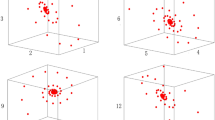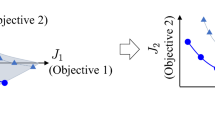Abstract
A novel genetic programming (GP) algorithm called parsimonious genetic programming (PGP) for complex process intelligent modeling was proposed. First, the method uses traditional GP to generate nonlinear input–output model sets that are represented in a binary tree structure according to special decomposition method. Then, it applies orthogonal least squares algorithm (OLS) to estimate the contribution of the branches, which refers to basic function term that cannot be decomposed anymore, to the accuracy of the model, so as to eliminate complex redundant subtrees and enhance convergence speed. Finally, it obtains simple, reliable and exact linear in parameters nonlinear model via GP evolution. Simulations validate that the proposed method can generate more robust and interpretable models, which is obvious and easy for realization in real applications. For the proposed algorithm, the whole modeling process is fully automatic, which is a rather promising method for complex process intelligent modeling.


Similar content being viewed by others
Explore related subjects
Discover the latest articles and news from researchers in related subjects, suggested using machine learning.References
Akaike H (1974) A new look at the statistical model identification. IEEE Trans Automat Control 19:716–723
Liang G, Wilkes D, Cadzow J (1993) ARMA model order estimation based on the eigenvalues of the covariance matrix. IEEE Trans Signal Process 41(10):3003–3009
Aguirre LA, Billings SA (1995) Improved structure selection for nonlinear models based on term clustering. Int J Control 62:569–587
Winkler S, Affenzeller M, Wagner S (2005) New methods for the identification of nonlinear model structures based upon Genetic Programming techniques. http://citeseer.ist.psu.edu/634350.html
Mendes EMAM, Billings SA (2001) An alternative solution to the model structure selection problem. IEEE Trans Syst Man Cybern A: Syst Hum 31(6):597–608
Feil B, Abonyi J, Szeifert F (2004) Model order selection of nonlinear input–output models using a clustering based approach. J Process Control 14(6):593–602
Koza J (1992) Genetic programming: on the programming of computers by means of natural selection. Cambridge, MIT Press
Madár J, Abonyi J, Szeifert F (2005) Genetic programming for the identification of nonlinear input–output models. http://citeseer.ist.psu.edu/720344.html
Pearson R (2003) Selecting nonlinear model structures for computer control. J Process Control 13(1):1–26
Chen S, Billings S, Luo W (1989) Orthogonal least squares methods and their application to nonlinear system identification. Int J Control 50:1873–1896
Vapnik VN (1998) The nature of statistical learning. Springer, New York
Acknowledgments
This work is jointly supported by NSFC and CAA under grant 60672179 and also supported by National Defense Advanced Research Fund Grant # 4132030103.
Author information
Authors and Affiliations
Corresponding author
Rights and permissions
About this article
Cite this article
Wei, Xk., Li, Yh. & Feng, Y. Parsimonious genetic programming for complex process intelligent modeling: algorithm and applications. Neural Comput & Applic 19, 329–335 (2010). https://doi.org/10.1007/s00521-009-0308-5
Received:
Accepted:
Published:
Issue Date:
DOI: https://doi.org/10.1007/s00521-009-0308-5




